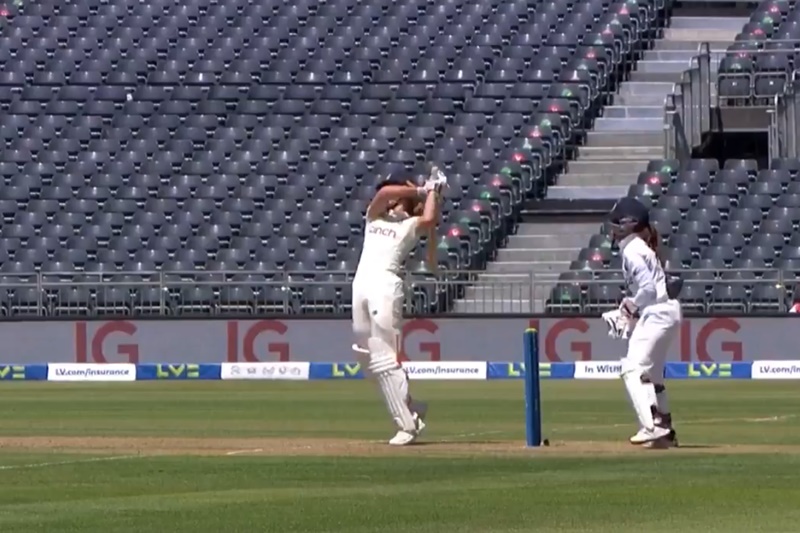Women’s Test matches are almost incomprehensibly rare – as evidenced by the fact that India are currently on a three-match winning streak which began in 2006. (The initial victory was followed by a bumper 2014 in which they played twice.)
England’s long format fixture list hasn’t generally been too congested either. Katherine Brunt – who has been playing international cricket since 2004 – has played all of 12 Tests.
Jan Brittin, who played for England, has the greatest number Test appearances to her name in women’s cricket. She turned out in 27 matches and had to play from 1979 to 1998 to achieve this. To provide some context, that’s the same number of Tests as Ben Hilfenhaus.
It’s also one fewer than Charles Bannerman.
Charles Bannerman is of course responsible for the greatest stat in cricket, having contributed the highest proportion of runs in a completed Test innings (67.35%) when he scored 165 not out in Australia’s 245 in the very first Test match. It’s such a famous statistic that it’s weirdly unnerving to think that in 1979 England’s Enid Bakewell made 68.29% of England’s total of 164 via an unbeaten 112.
Bakewell also took 10 for 75 in that game, as well as making 68 in the first innings – so, you know, pretty solid performance. It was her final Test. Anyone who aspires to ‘go out in style’ might as well accept that Enid ticked that one off pretty comprehensively so it’s probably not a thing worth striving for any more – you may as well just go out at a low ebb when you’re very much over the hill.
Anyway, back to the matter at hand, which is Test match No.141 between England and India. A final measure of the rarity of this event is that it has brought no fewer than six Test debuts – five for India, one for England.
Weird sort-of-related Bannermannish fact: Frank Woolley scored over 50% of England’s first innings runs in the 141st men’s Test match.



Enid Bakewell.
Test match batting average: 59.9 – test match bowling average: 16.6.
All rounder. Legend.
Enid Bakewell.
I imagine when an Australian captain (if she ever played for one) wanted her to bowl, they would do so by asking ‘cherry, Bakewell?’
More likely when playing against the Aussies a foul-mouthed opponent referred to her as “Tart”.
I can also imagine, in similar mode to a well-known story about Vic Richardson’s response to Douglas Jardine’s complaint about being called a bastard, one of the Aussie women asking: “which one of you tarts called this tart a tart?”.
If nobody can beat Enid Blakewell for going out in style, surely the best ever start to a career also belongs to the women’s game. In the first innings of the first ever Test, Myrtle Maclagan took 7-10 off 17 overs (full figures: 17-11-10-7) as Australia were bowled out for 47. In the second innings of the first ever Test, she opened the batting and scored 72 out of England’s total of 154.
She holds the record, uniquely, of having both taken the first ever Test five-for and scored the first ever Test hundred.
It spawned a verse that given the form of the men’s team might well be applicable in the next few days, especially if England wrap up the win against India tomorrow:
What matter that we lost, mere nervy men
Since England’s women now play England’s game,
Wherefore Immortal Wisden, take your pen
And write MACLAGAN on the scroll of fame.
Very much like the idea of a scroll of fame. That’s definitely how these things should be logged.
No OS, LS or SLA for NZ in the WTC? OMG, WTF, etc.
What’s the left arm wrist spin abbreviation?
The traditional SLC isn’t very PC. But SLU works rather well IMO. Definitely prefer SLU to SLW. Hate W in abbreviations/acronyms because it’s usually more long-winded to say double-u than whatever it is that the W was standing for (hence commentators often saying “LB” for “LBW” etc).
SLAWS works well as a single-syllable acronym for slow left arm wrist spin. It avoids the five syllables required to use the letter W in the abbreviation SLW and the un-woke three-syllable nickname for the delivery from centuries gone by.
TBF Ged I haven’t heard anyone read out SLA or OS or LS or RMF or LF as “slah” or “oss” or “Les” or “rumph” or “liff” so I’m not sure pronounceability is a KPI for bowling abbreviations. I do think there’s a preference for TLAs (for two possible definitions of “T”) over FLAs though.
I know you don’t do requests, KC, but…
…Shafali Verma?
We need answers.